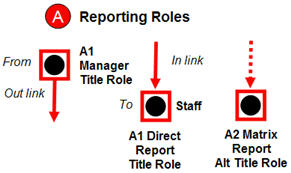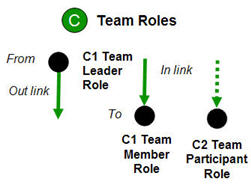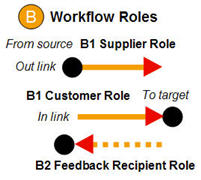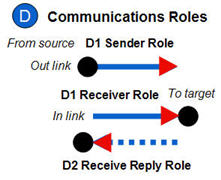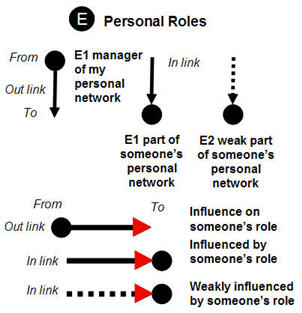Structural Links (A or C) Have Both Leadership and Membership Roles
|
Step 1 - Reports: Every position has an authorizing superior represented by the (A1) mutually-exclusive direct reporting link and thereby its one and only one “Title Role” or “job title”. At the other end of every position’s direct reporting link is a line manager role. The A1 is the Organization membership link, often practically represented by an employee badge. The title role is your job in the management team led by your boss. Some positions report into more than one organization as a matrix (A2) link, with a secondary title role in a second management team.
|
|
Step 2 - Teams: A position may have leadership or membership in multiple additional teams, each represented by a C1 group membership link. A position’s primary “Team Role” in each team is shaped by the team internally, including the Team Leader role. In addition to the C1 leader-member role, there may be a number of interrelated sub-roles played as part of the daily team dynamic. A C2 link may be used to indicate a less strong connection to the team, such as an occasional specialist, or a looser form of membership, such as a community of practice.
|
|
Process Links (B or D) Indicate an Input or Output Role
|
Step 3 - Workflows: A position in its team role may have workflow relationships (C) with other positions, either to other internal team positions and/or to external positions in other teams. Workflow roles are either as suppliers or customers in a given linked pair of roles, which are often link chains where intermediate positions serve as customer for an upstream supplier link and as a supplier in turn to a downstream customer role. A feedback relationship (C2) connects a downstream node to an upstream node, and is essential for system regulation. External customer-supplier relationships may be represented as inter-team links connected through each team’s leader.
|
|
Step 4 - Communications: All links, as a pair of interacting roles, can be considered communications relationships. Where additional patterns of horizontal connection between roles are needed, especially when information objects (e.g., documents) are involved, an information link (D) is used. A node plays either a sender or receiver role in each link, in each actual message interaction. Over time, a sender or receiver role may predominate in communications between any two nodes. Each communications link may generate a reply (D2) from the target back to the source node, which may in turn generate a reply, and so on…as, for example, a dialogue.
|
|
| |
Personal Links (E) Complete My Set of Roles
|
Step 5 - Personal: A person-in-position likely has a personal relationship with each paired person-in-position for most structure and process links (A, B, C), and many informational (D) exchanges. Directed personal links (E) are used to add any additional key relationship to my positional profile. While social links are often represented as “undirected” links (no arrowheads), their use in the organization network requires directed links (direction may, of course, be ignored for certain analytic purposes), Roles in personal relationships are myriad, but can be grouped as either membership links or influence links, thus partaking of both vertical and horizontal orientations present in the link taxonomy.
Personal links would not normally be appropriate in the external organization network map. They are likely to be used as private layer of links in internal team settings or in the local ecology of teams.
|
|
|
